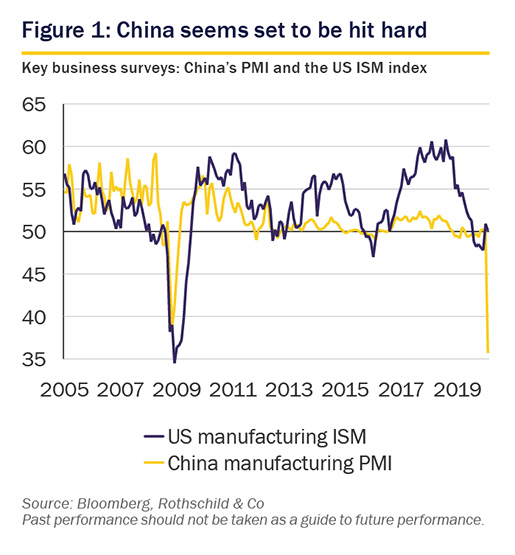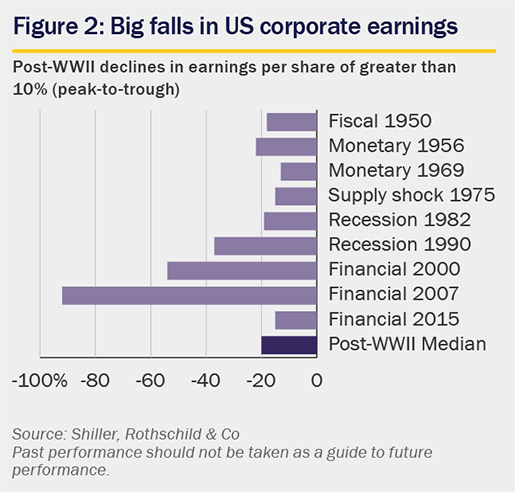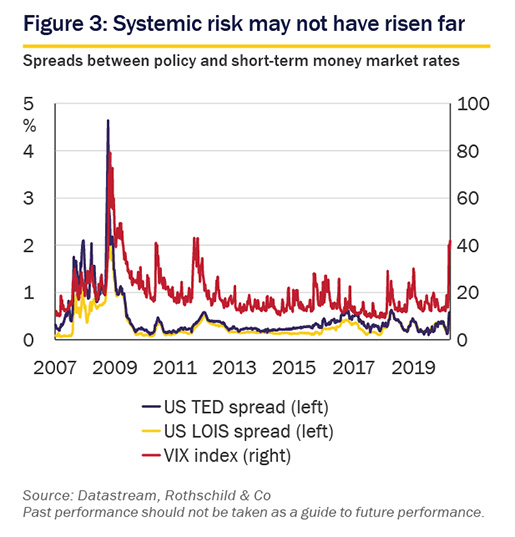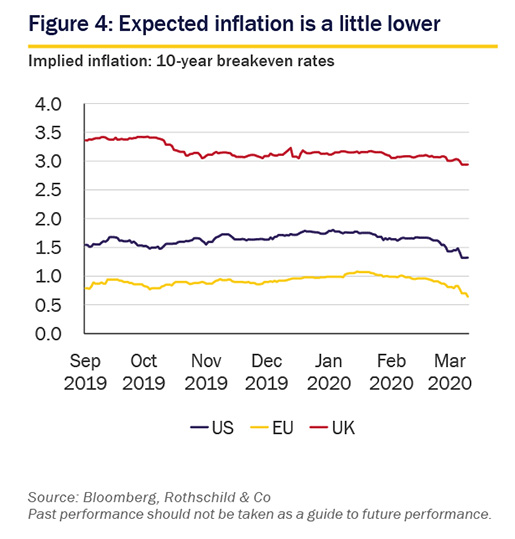Wealth Management: Market Perspective – This too shall pass

Kevin Gardiner, Global Investment Strategist, Wealth Management
Coronavirus: the economic questions
Could it cause a recession? It surely could - but we are far from sure that it will.
The economic damage is being done mainly by the understandable response to the virus, not the virus itself. Many more people are affected by cancellations and quarantines than are incapacitated by the illness. If controlling its spread means stopping people meeting, then it means stopping a lot of business.
This has been a deeply unpopular business cycle (despite - or perhaps because of - it having confounded so many pessimistic predictions). Pundits have not been slow to pounce on the virus as the latest reason for expecting its demise.
China's business surveys have fallen dramatically to lower levels even than in 2008.
Click the image to enlarge
Admittedly, seasonal effects can be big around Chinese New Year, but we can easily imagine overall GDP there, and in some big Western economies, falling. If the WHO were to declare a pandemic, the impact would be even greater.
Having receded at the end of 2019, as trade tensions abated and data seemingly stabilised, the prospect of recession does seem to have moved closer again.
It is not yet clear though whether the pending fall in “hard” data - sales, output, employment - will be comparably large, and sustained for a full quarter, let alone the two consecutive quarters that conventionally define a recession.
Many transactions will be permanently lost. Some, however, may be simply postponed, while others, like the household goods being stockpiled and the additional government outlays on prevention and treatment, would otherwise not have happened.
There has been some discussion about the likely shape of the rebound, when it comes. It was arguable whether the revival from the two-year-old slowdown that seemed to be ending in late 2019 was going to be vigorous or not, but we think there is less uncertainty surrounding the profile of the rebound when the coronavirus controls are eased. We expect it to be almost as sharp as the downturn.
What happens to earnings if it does?
Earnings are likely to fall, and stock prices have already fallen in anticipation. As noted, we do not think that recession has to follow, but it is important to be aware that corporate earnings are literally geared into economic growth: a small change in the latter can have a big impact on the former, and an even bigger one on stock prices.
A bumpy ride: earnings and stock pricesStock prices track (albeit loosely) corporate profits, which in turn tend to track (again, loosely) the economy. If the response to the virus hits economic growth, what sort of profit and share price shock might we expected? An outright fall in corporate earnings - as opposed to a slowing in the pace of growth - is relatively rare. But when it does happen, the retreat can be marked. It can also take some time to reverse: profits take 18 months on average to trough, before rebounding to their pre-crisis levels some 24 months later. Cyclical threats to corporate profitability are obvious: recession, the burden of higher financing costs or some policy-induced mishap. But historically these episodes, while most frequent, have not done the most damage. Click the image to enlarge The most destructive episodes have instead been associated with financial accidents, such as the collapse of the TMT bubble and the Global Financial Crisis (GFC). Such episodes can still have cyclical consequences of course: during the GFC, liquidity seizures and a weak banking system sparked a deep recession as business and individuals simply stopped spending. The looseness of the link between stock prices and earnings reflects sentiment and shifting market expectations, which often forces equity prices (and valuations) to depart from fundamentals. This was most recently visible at the end of 2018, where revived market volatility occurred during a period of stable, if unremarkable, earnings. The magnitude of the fall in earnings can diverge sharply from the extent and duration of the market setback. In the early 1990s, US corporates faced a challenging backdrop: tight monetary policy and a domestic recession (alongside an oil price shock as Iraq invaded Kuwait). Earnings fell by over a third, but the market response was modest, down a sixth at its nadir. Conversely, market volatility often exceeds that in earnings. Quantifying the virus-related threat is challenging. The risk of another recession has clearly revived, and we seem likely to see some fall in operating profits and earnings. As yet, however, we think that the decline may be small and short-lived. In the middle of the media onslaught, it can be difficult to remember that the lasting damage being done to corporate net worth may be small. If Global Inc were to lose, permanently, one month's net income, a crude estimate suggests its present value might be cut by around one quarter of a percentage point. Even in recently low-volatility markets, this is well within the bounds of 'normal' fluctuation. But sentiment can easily overshoot reality - in both directions. |
The key investment point, however, is that growing economies and profits are the norm, not the exception: when growth resumes, profits - and stock prices - usually rebound. The volatility in stock prices usually significantly overstates any underlying changes in the net present value of businesses.
Would a virus-driven downturn be worse?
Recessions can hit employment and profitability hard, if temporarily. Is the risk posed by a virus-inspired downturn now worse than that posed by a 'normal' one?
The initial downturn in output and sales will doubtless expose those businesses whose cashflow is thinnest and leverage highest, and their failures could hit overall liquidity hard. But there have been relatively few macro excesses in this cycle - banks and consumers have not been lending and borrowing recklessly - and these spillover effects may not be any larger than usual.
It is too soon to talk of another financial crisis. The fall in stock prices and the renewed 'inversion ' of the yield curve, as long-term US bond yields have dipped to new all-time lows, do not yet constitute one. The money market spreads that can signal growing systemic liquidity shortages have not yet widened alarmingly.
Click the image to enlarge
It is also too soon to talk of the end of 'globalisation', even as airports empty.
Set against this, there is less room than usual for interest rates to fall now because they are so low already (though central banks may be taking advantage of what room there is - see below). But even if rates could fall a long way, in the context of travel restrictions, contagion controls and consumer fear, their impact would surely be less potent than usual.
Fiscal policy has more room to respond, but again, outside the immediate relief and control spending, it may not do much in the face of such constraints. As we note below, it is a moot point as to whether monetary and fiscal policy should be trying to do much now.
Nonetheless, we suspect that a recession - which as noted might yet be avoided - on this account might be less potent than one needed to correct consumer or inflation excesses. The very clear and non-economic cause of this downturn, and the absence of recent excess, arguably makes it less daunting than a more deep-seated economic or financial malaise.
Is it a supply or demand shock?
If the economy gets bigger because people decide to spend more, we talk of growth as being 'demand led'. This is probably the default setting - it is certainly the establishment or Keynesian worldview. But growth can sometimes be driven by a resources or technological windfall, in which case we say it is 'supply led'.
Why might it matter?
A sudden reduction in demand would likely result in a weakening in prices (deflation) alongside the fall in activity, as suppliers entice more hesitant customers to keep buying. But a sudden reduction in supply would likely result in rising prices (inflation) alongside the fall in activity, as customers compete for scarcer products. Profit margins might also be affected differently depending on exactly where the downward impetus comes from.
The financial crisis was largely driven by a collapse in demand, and was deflationary. Industrial unrest in the 1970s resulted in a fall in supply, and was inflationary.
The response to the coronavirus, however, is surely hitting both demand and supply. Travel restrictions and panic are preventing people from spending as they usually would - but they are also preventing them from going to work and producing stuff.
Oil prices have fallen sharply because oil supply has been less affected than demand, and the net impact does look deflationary. As figure 4 shows, the breakeven inflation expectations priced into bond markets have fallen a little. But the fall in activity, not the impact on consumer prices, is the main effect.
Click the image to enlarge
Who is most exposed?
An interruption to business combined with fear is as clear a case for weaker stock prices and stronger safe-haven assets as you could want. On the front lines are oil (where the shock is entirely demand-driven), travel, hotels, distribution services and financials affected by lower interest rates (see below) - but also riskier stocks (and speculative grade bonds) in general, which suffer from the flight to safety. Geographically, the sell-off rolled from Asia to the West.
High-quality government bonds have performed predictably - predictably, that is, if you'd known there was going to be a scare - and surged in value. So did gold, and the newly fashionable (but to us uninvestable) cryptocurrencies, before falling back sharply. The response of currencies also failed to match the usual pattern: the dollar, yen and franc have firmed as usual - but more recently so too has the euro, which is not usually seen as a safe port in a storm.
We think that the impact may be brief, and that markets are overreacting, and so would be more inclined to buy some of the losers (not the energy sector, which increasingly faces more structural headwinds) and sell some of the winners.
What should/can policymakers do?
Should policymakers even try to arrest a looming downturn on this account? As noted, on one hand the powers that be have decided that some economic dislocation is a necessary firebreak for contagion. If, with the other hand, they try to resist that dislocation, then why bother to begin with?
Of course, central banks are independent, and will do what they think is best in pursuit of their mandates. In early March, the US Federal Reserve (Fed) unexpectedly cut its main policy rate - the Fed funds rate - by 50bp, taking the targeted range to 1-1.25%. It usually moves in smaller increments, and the FOMC's next scheduled meeting was still two weeks away at the time.
The Fed has cut interest rates by larger than usual amounts, and between meetings, before - most recently in 2008, 2007 and 2001, which were times of significant market turbulence. It would seem that the central bank thinks things now are comparably serious.
Other central banks have cut rates - including the People's Bank of China, and the Reserve Bank of Australia. The European Central Bank and the Bank of England have indicated they are also considering easing.
We are in two minds about these monetary responses. Even if some action is desirable, if US manufacturers' supply chains (for example) are missing components from China, lower US rates are hardly going to magic them into being.
Maybe the Fed sees some companies facing financial distress - but if so, the more logical response might have been the direct provision of liquidity, not a cut in borrowing costs (from levels which were low, and widely fixed, to begin with). Credit spreads have certainly widened, but not yet to extreme levels, and as noted, money market spreads have not yet surged alarmingly.
But apart from encouraging investors psychologically to rely on central banks' support even more than they already were, the moves may not do much damage.
What should we be watching?
Talk of the downturn being confined within a single calendar quarter, or of an eventual rebound, may sound optimistic now. But epidemiologists (real ones) suggest that epidemics often follow distinct profiles, influenced by 'reproduction rates', the mathematics of contagion and immunity. Typical curves follow a 'sigmoid' or S-shaped profile.
We are watching figure 6, which shows that China - if we believe its data - may now have passed the inflection point that marks the slowing of contagion. The rest of the world is still some way behind - note the drastically lower scale - but if the timescale is echoed, we could indeed be talking about weeks rather than months before global contagion slows too.
Click the image to enlarge
Existentially, the emergence of a new virus is unsettling, and the apparent fatality rate of around 3% is worse than many others. But at some stage, people (and their governments) will accept (or feel able publicly to accept) that the threat of pandemic is always with us, and get back to business. And that fatality rate may be overstated, as the number of cases almost certainly understates overall infection levels.
Investment conclusion
The collective response to the virus is understandable: in a world that has never been safer from violence or pestilence, any revival in danger is alarming. Our thoughts are with the affected families. Nonetheless, we suspect it may not last for long. The declines in stock market values look to us to be much larger than the likely damage done by that response to the net present value of lost business.
Stock prices had risen a long way beforehand: we'd suggested in February that they may have been tactically a little ahead of themselves. But the scale of the correction looks overdone. We do not advise chasing the markets lower, but instead think that long-term investors should be looking for opportunities.
Click here to continue: Market Perspective: Economy and markets: background
In this Market Perspective:
- Foreword
- This too shall pass (current page)
- Economy and markets: background
- Important information
Download the full Market Perspective in PDF format (PDF 1.1 MB)




